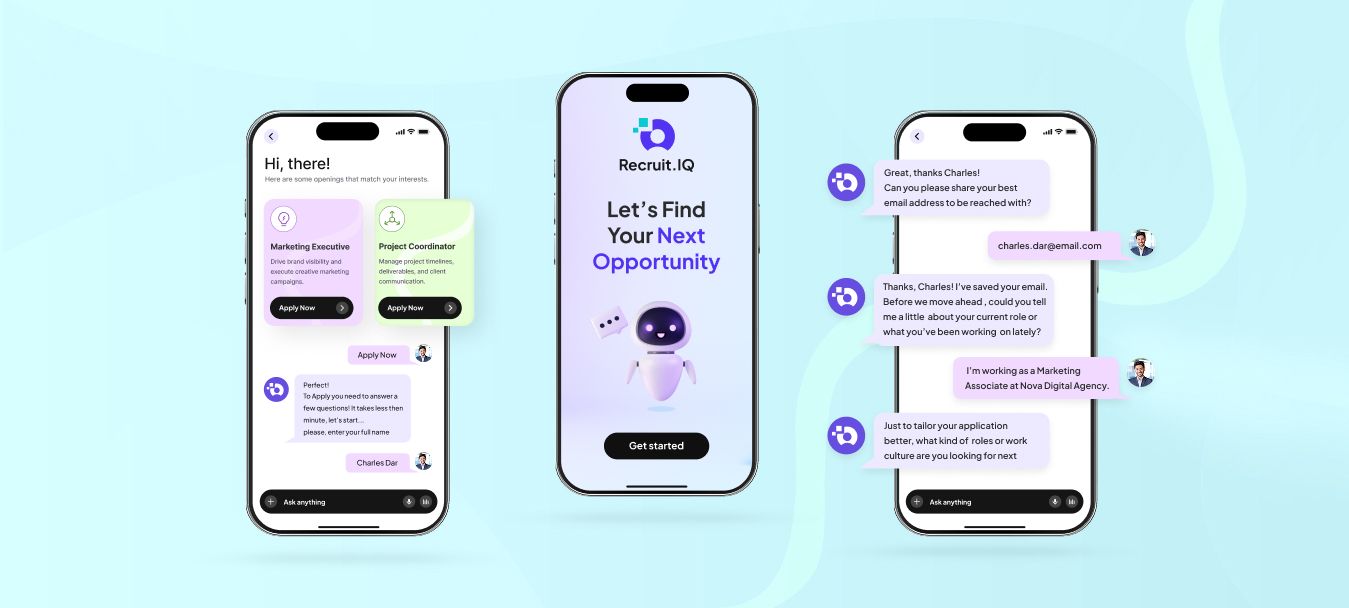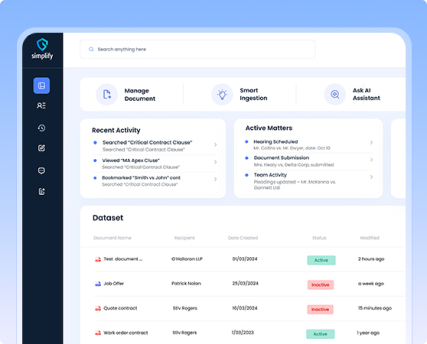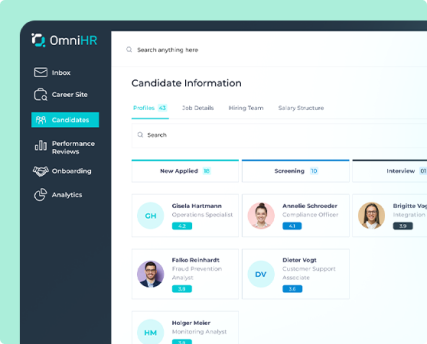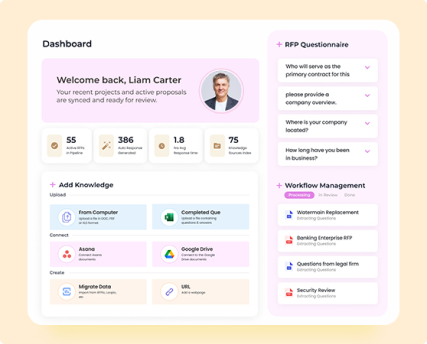Angular development with React was our first choice to build the frontend of the conversational recruitment platform. Angular powers the recruiter dashboard and admin controls, while React handles the candidate-facing chatbot interface.

Skip Setup Headaches and Start Your Project Fast - Download Free Boilerplates
Client Background
Recruit.IQ is a full-cycle recruiting automation software (web app) that handles a high volume of candidate data who are applying for jobs. The core client base includes organizations that are looking for recruitment workflow automation and simplified internal workflows.
Country
Australia
Industry
HRTech
Hours Invested
20,000+
Team Size
3-4 Resources
Business Problem
Recruitment processes can be increasingly time-consuming and inefficient. In high-volume, high-turnover workforce segments, this inefficiency slows hiring and productivity and makes scaling nearly impossible. RecruitIQ’s existing software worked fine for basic workflows, but the team wanted to bring in more advanced automation, particularly conversational AI for recruitment to handle screening, data updates, candidate queries, and engagement without needing human intervention at every step.
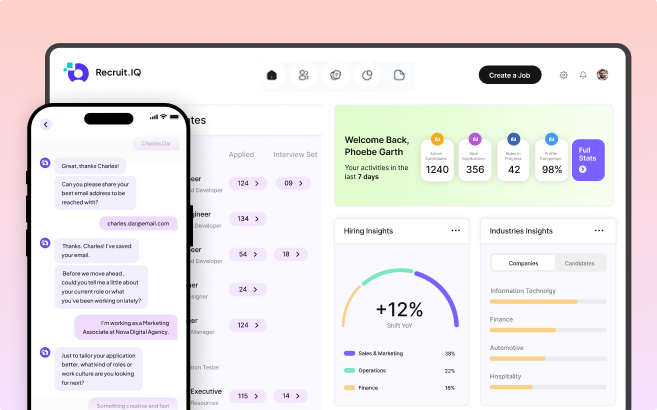
Project Brief
Recruit.IQ needed to make its recruitment web app faster, more efficient, and less dependent on manual work. All the tasks that recruiters were spending hours on could be automated. Hence, we were tasked with developing an AI model - a custom GPT-3.5 chatbot that’s compatible with their clients’ ATS and CRM. The chatbot handles screening conversations with applicants, filters candidates based on skills and job criteria, and automatically attaches resumes and compliance documents to their profiles.
A Reconnect process was also built to keep the database active. It refreshes candidate details in the background and syncs any new information without manual input. The GPT chatbot for recruitment runs 24/7, answers common candidate questions, and updates records in real time.
This integration changed RecruitIQ’s existing system into a more autonomous recruitment setup that runs efficiently even under high-volume workloads.
Client Input

We didn’t want to force recruiters to change how they work, nor did we want another chatbot that just answers questions. The GPT integration gave us that. It fits perfectly into the existing process but handles most of the grunt work automatically. It’s the first time our system has felt genuinely responsive.
We spent a lot of time training GPT to understand their workflows. It had to know when to screen, what to flag, and when to loop a recruiter back in. Instead of the language, the challenge was logic. And to make sure the AI behaved like a recruiter’s assistant, not a random chatbot, took some real iteration.

Vishal Siddhpara
Core Challenges
- Integrating GPT with existing ATS and CRM that had inconsistent APIs and undocumented fields made real-time syncing unpredictable until a custom mapping layer was built.
- Getting GPT to interpret recruiter intent correctly, as in when to shortlist or just record data took several prompt refinements and controlled logic overrides.
- Handling incomplete candidate data was a complex task. The AI recruitment assistant needed fallback logic to keep conversations flowing without losing information or context.
- Recruiters expected the chatbot to mirror human tone, but early versions sounded robotic. We had to fine-tune prompt templates for natural, professional responses.
- Continuous updates from both AI-enhanced ATS/CRM platforms and chatbot often created duplicate records. Hence, syncing logic had to be rewritten to detect and merge data in real time.
Solution Scope

AI-Powered Screening & Shortlisting
The GPT chatbot for ATS/CRM can handle a high volume of candidates applying for job orders and evaluate their profiles based on job requirements directly through the chat interface.

Real-Time Data Sync (Reconnect Module)
We implemented a background module that continuously updates the candidate pool and syncs new data and resumes with the database to keep records current and accurate. This has helped the client eliminate data gaps and manual refresh cycles.

Automated Compliance Management
Our AI developers configured the chatbot to collect all required compliance documents from candidates before submission to job orders, so that every profile meets regulatory and client standards.

Workflow Automation Engine
As we utilized Recruit.IQ’s automation task configuration, recruiters could reduce or completely eliminate repetitive activities in the HR and recruitment management system such as data updates, reminders, and routine follow-ups.

24/7 Conversational Support Bot
The AI recruitment assistant is available 24/7 to respond to candidate queries instantly. As a result, recruiter workload has reduced with a notable improvement in communication TAT.

ATS/CRM Integration Layer
Integrated all chatbot interactions directly with clients’ existing systems, ensuring that every candidate update, document, and note is automatically reflected in real time.
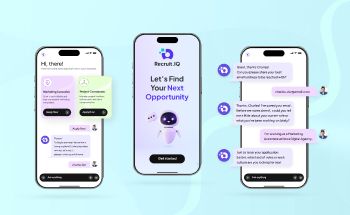
Receive a custom execution roadmap detailing cost, infrastructure fit, and payback period.
Technology Stack Used
Frontend
Backend
On the backend, .NET Core managed core business logic like candidate screening and document validation. We also used Node.js for handling real-time chat sessions with GPT and API requests from the chatbot to the main system.
Database
MySQL served as the central data layer. It's highly useful for storing candidate details, chat histories, and automation logs in a structured format.
Deployment Server
Everything ran on Azure Cloud, which gave us a flexible setup. The AI recruitment automation software could scale up during heavy recruitment cycles and sync with clients’ internal tools.
Business Value Delivered
The implementation of the Gen AI solution, i.e., the enterprise recruiting chatbot, transforms the recruitment process into a more efficient, scalable, and candidate-centric experience.

Higher Candidate Conversion Rates
Automated, yet personalized, conversations through GPT-3.5 helped retain 1 in 3 candidates who would’ve otherwise dropped off mid-process. This has directly improved placement volumes across job orders.

Always-On Talent Pipeline
With Reconnect running in the background, Recruit.IQ kept over 97% of candidate records actively synced and updated. It could maintain tens of thousands of active profiles without manual updates.

Shorter Response Loops with Clients
Automating compliance and documentation upfront allows recruiters to submit candidate profiles to clients 3X faster. In fact, most job order responses were completed within 24 hours.

Improved Resource Utilization
AI recruiting automation handled roughly 60-70% of administrative tasks. ATS chatbot integration freed up bandwidth equal to one full recruiter per team. Companies could expand capacity without new hires.
Access a full-stack AI team, with data engineers and ML specialists available within 5 business days.



